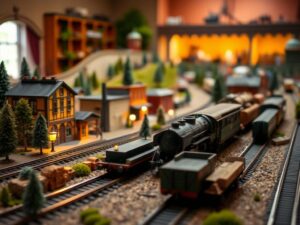How to Service Older HO Scale Models for Optimal Performance
How to Service Older HO Scale Models for Optimal Performance
How to Service Older HO Scale Models for Optimal Performance
Hey fellow railroaders!
Have you ever pulled out a vintage HO scale model from the dusty corner of your layout and felt a surge of nostalgia? Thereâs just something magical about those classic locomotives and rolling stock â the detail, the paint schemes, the history they embody. But letâs face it, those old models sometimes need a little TLC to keep them chugging along like new!
Servicing older HO scale models might seem daunting, but fear not, budding technicians! With a few basic tools, some patience, and this comprehensive guide, you can breathe new life into your vintage gems. Letâs dive in!
Why Service Your Old Models?
Before we get our hands dirty, itâs important to understand why servicing older HO scale models is essential:
- Optimal Performance: Wear and tear over time can lead to sluggish movement, jerky starts and stops, inconsistent speed control, or even complete malfunctions. A good service ensures smooth operation and accurate performance.
-
Enhanced Longevity: Proper maintenance prevents further damage and extends the life of your beloved models. Replacing worn-out parts, cleaning mechanisms, and lubricating gears can significantly delay future repairs.
-
Restored Appearance: Even if your model runs smoothly, years of dust and grime can dull its shine. Cleaning and touch-up paint can restore its original glory.
- Pride of Ownership: There’s a profound satisfaction in reviving a vintage train and knowing youâve contributed to preserving a piece of railroad history.
Getting Started: Tools of the Trade
You don’t need a high-tech workshop to service your HO scale models. Here’s a basic list of tools youâll find helpful:
-
Screwdriver Set: Phillips and flathead in various sizes are essential for removing screws and accessing internal components.
-
Pliers: Needlenose pliers are handy for delicate wire work, while regular pliers can grip larger parts for removal.
- Hobby Knife: Useful for trimming excess material or carefully opening stubborn parts.
- Magnifying Glass: Provides a close-up view of small parts and intricate details.
-
Brushes: A range of sizes (fine-tipped, medium, large) is helpful for cleaning components, applying lubricants, and detailing work.
-
Lubricants: Light machine oil or silicone oil specifically formulated for model trains are ideal choices. Avoid using petroleum jelly, as it can attract dirt and grime.
- Cleaning Supplies: Soft cloth, cotton swabs, soap-free detergent (for plastic parts), and alcohol for degreasing.
-
Isopropyl Alcohol (70%): This versatile solution helps clean contacts and dissolve grease and grime.
A Step-by-Step Servicing Guide
Hereâs a detailed guide to servicing your HO scale model trains, broken down into manageable steps:
1. Inspection & Diagnosis: Before you begin disassembling anything, take time to thoroughly inspect your model.
- Look for any loose or missing parts.
- Observe how the wheels roll and check for signs of wear, debris, or uneven movement.
- Examine the electrical connections for corrosion or loose wiring.
2. Cleaning & Disassembly:
Next, carefully remove the screws holding your model’s shell together (if applicable). Once you have access to the inner workings, clean all components using appropriate methods:
-
Wheels & Axles: Gently use a soft cloth and alcohol solution to wipe away grease and dirt. For stubborn grime, a toothpick can help lift debris from between wheel flanges.
-
Motor Housing: Carefully vacuum any dust or debris within the motor housing. If the brushes appear worn or corroded, itâs time for replacement.
-
Electrical Components:
Clean solder connections and use an alcohol swab to remove oxidation. Inspect wire insulation for damage.
3. Lubrication & Adjustment:
After thorough cleaning, apply a light film of lubricant (like silicone oil) to the following areas:
- Bearings & Gearsets: A drop or two on each gear can help ensure smooth rotation and minimize friction.
-
Worn-out Drive Train: Replace any worn gears, shafts, or bearings with new ones (consult your manufacturer’s website for replacement parts).
- Electrical Contacts: Carefully clean contacts and lightly apply a dielectric grease to improve conductivity.
4. Reassembly & Testing: Once all components are lubricated and repaired, reverse the disassembly process. Secure all screws and double-check that no wires are tangled or loose.
- Run your serviced model on your layout. Start with low speeds and gradually increase to observe its performance. Listen for any unusual noises, check for jerky movements, and make adjustments as needed.
Advanced Techniques & Restoration Tips:
Beyond the basics outlined above, here are some advanced tips to further enhance your servicing capabilities:
-
Understanding Schematics: Referring to electrical schematics (often available online) can help you troubleshoot complex issues or modifications.
-
Decoder Installation: For adding sound and advanced functionality, consider installing a decoder. This opens up a whole new world of customization.
- Airbrushing & Detailing: Master airbrushing techniques and specialized paints to create weathered effects and truly realistic finishes.
Keeping Your Classics Running Smoothly: A Maintenance Schedule:
Regular maintenance is key to preventing major issues down the road. Aim for these checks and services:
-
Monthly Inspection: Visually inspect wheels, gears, electrical connections, and general condition.
- Annual Servicing: Deeper cleaning, lubrication, and tightening of all components every year ensures optimal performance.
Embrace Your Inner Model Train Historian!
Remember, each vintage HO scale model is a time capsule representing a bygone era in railroad history. The thrill comes from bringing those models back to life, respecting their legacy while adding your own personal touch.
Don’t hesitate to connect with other hobbyists online or at local train clubs â theyâre a wealth of knowledge and camaraderie! Share tips, troubleshoot issues together, and celebrate the magic of model trains.
Happy Servicing, fellow rail fans!




